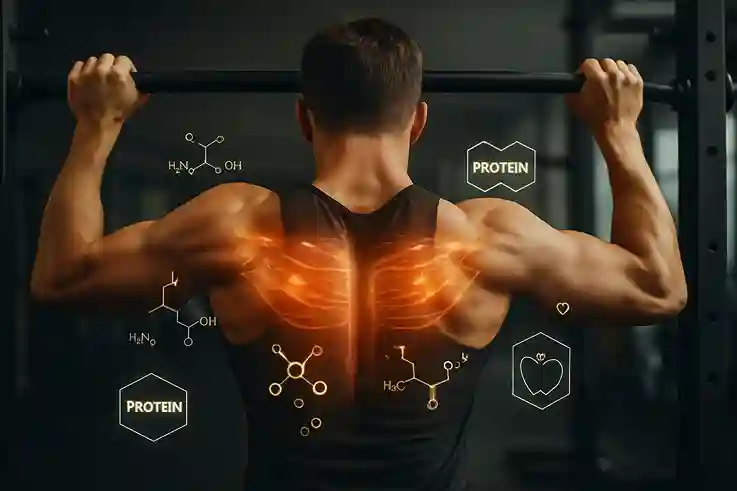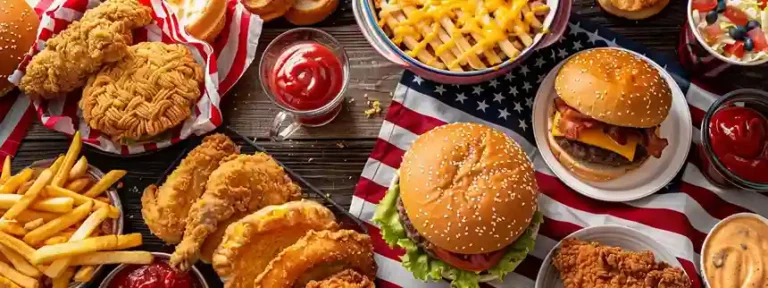High protein foods are essential for building muscle and boosting recovery, especially for anyone serious about fitness. But their benefits go far beyond the gym. A diet rich in quality protein supports fat loss, fuels long-lasting energy, and enhances overall strength.
Whether you’re lifting heavy, training for endurance, or simply trying to stay lean and active, the right protein sources can reshape how your body performs—and how it looks.
In this expert-backed guide, you’ll discover the most powerful high protein foods, both animal- and plant-based. We’ll break down their nutritional value, when to eat them for optimal results, and how to incorporate them into your daily routine. Plus, you’ll see real-world transformation stories that prove just how effective these foods can be when used with intention.
Let’s unlock the full potential of high protein eating—starting now.
Why Protein Is Essential for a Stronger Body
Protein Repairs and Builds Muscle
After every intense workout—whether it’s heavy lifting, HIIT, or even a long run—your muscles go through tiny, invisible breakdowns called micro-tears. It’s not a sign of damage; it’s the natural process of muscle adaptation. But here’s where protein becomes critical: your body uses it like a repair crew, rushing amino acids to rebuild those fibers, making them stronger, thicker, and more resilient over time. Without enough protein in your system, this repair process stalls. Recovery slows, soreness lingers, and gains plateau. Even when you’re not exercising, your body constantly breaks down and rebuilds muscle tissue, especially if you’re active.
Protein helps preserve this lean muscle mass, which is essential not just for athletic performance but for something people often overlook—your metabolism. Muscle burns more calories at rest than fat, so the more lean mass you maintain, the more efficiently your body uses energy. Whether your goal is to bulk up, get lean, or simply feel stronger, skimping on protein holds you back from real, sustainable progress.
Boosts Metabolism and Burns More Fat
High protein foods naturally raise the thermic effect of food (TEF)—a science-backed way your body burns calories during digestion. Unlike fats and carbohydrates, protein requires significantly more energy to break down and absorb. That means every high protein meal not only fuels your muscles, but also increases calorie burn during the digestion process itself. It’s a subtle metabolic advantage, but over time, it adds up—especially if you’re trying to lean out or manage your weight.
Beyond the calorie burn, protein has another superpower: it keeps you full. Meals rich in protein slow down digestion, helping you feel satisfied longer and cut down on those between-meal cravings. When you’re full and fueled, you’re less likely to reach for sugary snacks or overeat at your next meal. This is why protein supports both fat loss and muscle gain at the same time—a rare balance that makes it essential for anyone reshaping their body.
Common Myths About High Protein Diets
One of the most common concerns people raise about high protein diets is kidney health. You’ve probably heard that too much protein can damage your kidneys—but this idea has been largely misunderstood. Research consistently shows that in healthy individuals, high protein intake does not harm kidney function. That warning only applies to people who already have pre-existing kidney disease.
For active individuals, athletes, or anyone trying to build or maintain muscle, protein needs are actually higher than the outdated daily recommendations suggest. In other words, most fitness-focused people aren’t eating “too much”—they’re often not eating enough.
Another myth floating around is that eating more protein will make you bulk up like a bodybuilder overnight. The truth? Muscle gain is a slow, intentional process, built over weeks and months of consistent training, recovery, and the right nutrition. Protein doesn’t magically turn into muscle—it supports the process by repairing and strengthening fibers broken down during exercise. If you’re lifting heavy and eating smart, protein will help you gain lean mass. But if your goal is to stay lean or tone up, protein still plays a crucial role—it helps preserve your existing muscle while burning fat. So no, protein won’t make you bulky—it’ll make you strong, sculpted, and resilient.
Stop Feeling Tired All the Time
Feeling constantly drained after workouts? Struggling to bounce back, even after a good night’s sleep? It might not be your training—it might be your protein. Fatigue is one of the most overlooked signs of inadequate protein intake, especially if you’re pushing your body with regular exercise. Without enough protein, your muscles can’t fully repair, your recovery slows down, and your energy levels stay low no matter how clean the rest of your diet is.
The fix isn’t complicated—but it is consistent. By adding high protein foods to every meal, you give your body the tools it needs to rebuild and refuel. You’ll notice more than just better recovery. Many people experience improved mental clarity, fewer energy crashes, and a stronger sense of alertness throughout the day. Protein doesn’t just build muscle—it builds resilience. If you’re serious about feeling strong, focused, and ready to train harder, protein is non-negotiable.
Top Animal-Based High Protein Foods for Muscle Growth
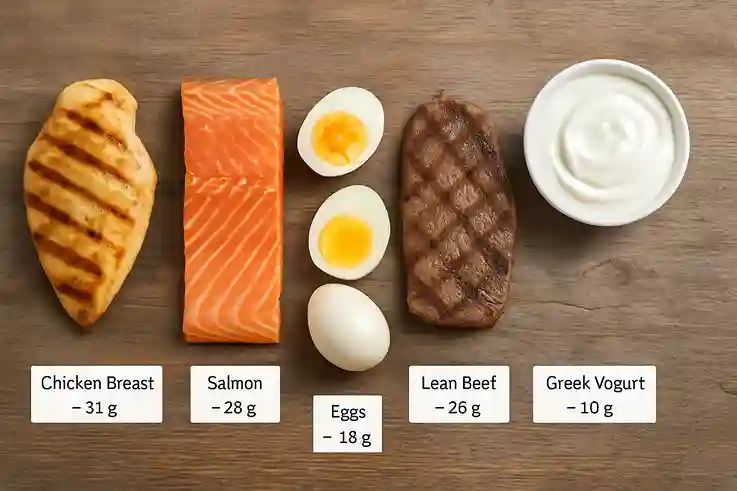
Animal-based proteins are considered “complete proteins” because they contain all nine essential amino acids—those that your body cannot synthesize on its own. These amino acids are the building blocks of muscle tissue and are critical for recovery, repair, and growth. Unlike many plant-based sources that may lack one or more essential amino acids, animal proteins provide a well-rounded, highly bioavailable profile that your body can use efficiently and immediately after consumption.
1. Chicken Breast
Chicken breast remains a staple in high-protein diets for good reason. It’s lean, nutrient-dense, and packs an impressive 31 grams of protein per 100 grams—all with minimal fat. That makes it ideal for those aiming to build muscle while keeping calories in check. Its mild flavor and tender texture also make it incredibly easy to incorporate into a variety of meals. You can grill it for meal prep, bake it with herbs for dinner, or shred it into salads and wraps for a quick post-workout bite. It’s not just convenient—chicken breast offers a fast-digesting, complete protein that helps kickstart recovery right after training. For anyone training consistently, this simple food delivers consistent results.
2. Eggs
Eggs are one of the most nutrient-dense and complete protein sources you can include in your diet. A single large egg provides about 6 grams of high-quality, easily digestible protein, making it perfect for both pre- and post-workout meals. But the benefits go beyond just protein. Eggs also deliver key nutrients like vitamin D, which supports bone strength and hormone balance, and choline, a compound that plays a vital role in brain health and muscle function.
And while the egg white holds most of the protein, don’t toss the yolk. The yolk contains healthy fats, essential amino acids, and micronutrients that support muscle recovery and satiety. It also provides antioxidants like lutein and zeaxanthin, which promote eye health—especially important for those who spend time training outdoors. Whole eggs fuel your body and brain, making them a smart, affordable, and highly versatile addition to any high-protein meal plan.
3. Salmon
Salmon is a standout among high protein foods—not just for its 25 grams of protein per 100 grams, but also for its rich content of omega-3 fatty acids. These healthy fats do more than support heart health—they actively reduce exercise-induced inflammation, improve joint mobility, and accelerate muscle recovery. That makes salmon especially valuable for strength-focused athletes or anyone pushing through intense training cycles.
Unlike leaner meats, salmon provides both protein and essential fats in one naturally balanced package, helping to support hormone production and long-term endurance. For a complete recovery meal, pair a salmon fillet with quinoa for slow-digesting carbs and a side of leafy greens to boost micronutrient intake. Whether grilled, baked, or air-fried, salmon offers a delicious way to fuel your body, fight fatigue, and stay injury-free.
4. Lean Beef
Lean beef is a nutritional powerhouse for muscle growth and strength, offering about 26 grams of complete protein per 100 grams. But its value goes far beyond just protein content. It’s rich in iron, which supports oxygen transport through red blood cells—critical for endurance and recovery. Zinc plays a role in immune health and muscle repair, while creatine, naturally found in red meat, helps improve performance during high-intensity training.
For those serious about strength gains, lean beef offers a unique advantage: it fuels recovery while supporting key physiological functions behind the scenes. To keep your meal clean and heart-healthy, opt for leaner cuts like sirloin, eye of round, or top round roast. These provide the benefits of red meat without excess saturated fat. Whether pan-seared, slow-cooked, or grilled, lean beef is one of the most complete, muscle-friendly foods you can add to your routine.
5. Greek Yogurt
Greek yogurt offers a unique combination of casein and whey proteins, giving your body both immediate and sustained muscle support. Whey digests quickly, making amino acids available fast, while casein releases them slowly over several hours. This makes Greek yogurt an ideal pre-bedtime snack, helping to support overnight muscle repair and minimize muscle breakdown while you sleep.
With about 10 grams of protein per 100 grams, it’s an excellent choice for anyone looking to increase their protein intake without heavy preparation. Greek yogurt also contains calcium, probiotics, and B vitamins, which support bone health, digestion, and energy metabolism. For an extra nutritional boost, try topping it with fresh berries for antioxidants or a spoon of peanut butter for healthy fats and added flavor. Whether as a snack, dessert, or breakfast base, Greek yogurt is a simple, powerful ally in any high-protein diet.
Animal Protein Sources – Protein Per 100g & Benefits
| Food | Protein (per 100g) | Key Benefits |
|---|---|---|
| Chicken Breast | 31g | Lean, versatile, fast recovery |
| Eggs | 13g | Nutrient-rich, easy to digest |
| Salmon | 25g | Omega-3s, anti-inflammatory |
| Lean Beef | 26g | Iron, creatine, strength support |
| Greek Yogurt | 10g | Casein + whey, gut-friendly |
Post-Workout Picks
For fast recovery, chicken breast and salmon are ideal due to their amino acid profile and digestibility. Eggs and Greek yogurt are great for lighter meals or snacks that still pack a punch. Combine these with carbs to refuel muscles effectively.
High Protein Plant Foods That Power Your Training
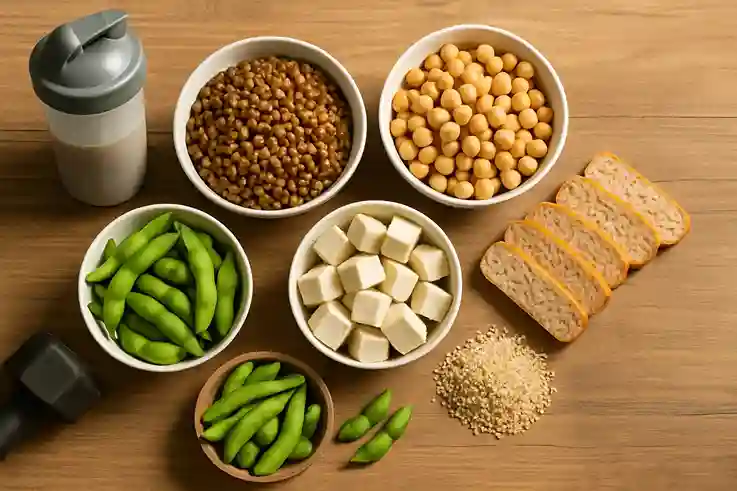
Plant-based foods can fuel serious strength and endurance—when chosen and combined wisely. While many plant proteins are incomplete on their own, they can still offer all nine essential amino acids when combined correctly throughout the day. That means you don’t need to eat meat to build muscle—you just need to be strategic.
Unlike animal sources, some plant proteins lack one or more essential amino acids. But here’s the good news: complementary proteins—like beans with rice or lentils with quinoa—can work together to fill in those gaps. And many plant-based athletes are thriving proof that you can get strong, lean, and energized on plants alone.
What’s more, plant proteins often come packed with fiber, vitamins, and antioxidants that support digestion, heart health, and recovery—giving you a broader nutritional benefit with every bite.
1. Tofu
Tofu is made from soybeans, one of the few plant-based sources that’s a complete protein—meaning it provides all nine essential amino acids your body needs for muscle repair and growth. With about 8 grams of protein per 100 grams, plus key nutrients like iron and calcium, tofu supports both muscle recovery and bone strength, making it an ideal choice for plant-based fitness enthusiasts.
It’s also low in fat, cholesterol-free, and extremely versatile in the kitchen. Tofu works in stir-fries, wraps, grilled dishes, or scrambles, and its neutral flavor absorbs marinades beautifully. Pressing tofu before cooking improves its texture and allows it to soak in more flavor, making each meal both nutritious and satisfying.
2. Lentils
Lentils pack around 9 grams of protein per 100 grams (cooked), making them one of the top plant-based proteins available. They’re also rich in fiber, iron, and B vitamins, which support energy metabolism, gut health, and muscle recovery—perfect for anyone training consistently.
While lentils aren’t a complete protein on their own, pairing them with whole grains like brown rice or quinoa creates a full amino acid profile. They’re easy to cook, budget-friendly, and work well in soups, curries, or protein-packed salads that keep you full and energized.
3. Chickpeas
Chickpeas deliver 8–9 grams of protein per 100 grams, along with complex carbs and plenty of fiber. This combo makes them excellent for sustained energy and steady blood sugar, especially during long or high-intensity training sessions. They’re also a solid source of iron and magnesium—key minerals for performance and recovery.
They’re incredibly versatile: roast them for a crunchy snack, blend into hummus, or toss into salads and grain bowls. Chickpeas support both muscle-building and endurance, making them a must-have for any plant-powered fitness plan.
4. Tempeh
Tempeh packs a serious punch with about 19 grams of protein per 100 grams, making it one of the most protein-rich plant-based options. Made from fermented soybeans, it’s not only a complete protein but also rich in iron, calcium, and probiotics—a powerful combo for muscle repair and long-term gut health.
Its fermentation process enhances digestibility, making it a smart choice for athletes who want to absorb nutrients efficiently while avoiding bloating. Tempeh has a firm, meaty texture that works well in stir-fries, sandwiches, or grilled as a post-workout meal base.
5. Edamame
Edamame are whole, young soybeans and another complete protein source. One cup provides around 17 grams of protein, along with fiber, folate, and vitamin K. Snack on them post-workout or toss into rice bowls for a quick recovery meal.
6. Quinoa
Quinoa stands out because it’s a grain that’s also a complete protein—rare in the plant world. It delivers about 8 grams of protein per cup (cooked) and pairs well with beans or vegetables. It’s light, filling, and ideal for post-training meals.
Plant-Based Sources – Protein + Fiber Value
| Food | Protein (per 100g) | Fiber (per 100g) | Complete Protein? |
|---|---|---|---|
| Tofu | 8g | 1g | ✅ Yes |
| Lentils | 9g (cooked) | 8g | ❌ Combine with grains |
| Chickpeas | 9g (cooked) | 7g | ❌ Combine with rice |
| Tempeh | 19g | 4g | ✅ Yes |
| Edamame | 11g | 5g | ✅ Yes |
| Quinoa | 8g (cooked) | 2.8g | ✅ Yes |
Combine for Complete Nutrition
To get the most from plant-based high protein foods, combine them with healthy fats and complex carbs. Think lentils with olive oil and brown rice, or tofu with avocado and sweet potato. These combinations support muscle repair, fuel workouts, and sustain energy levels for hours.
Plant protein isn’t just a substitute—it’s a serious strength-building tool when used right.
Grab-and-Go High Protein Snacks for Busy Athletes
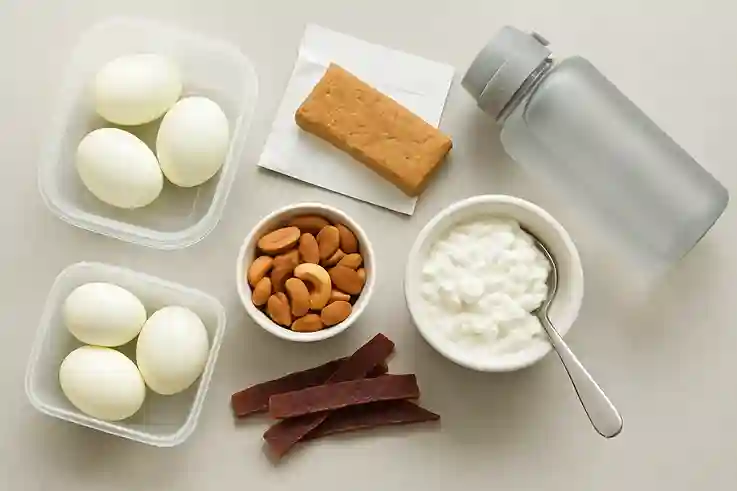
You don’t always need a full meal to hit your protein target. Smart snacking with high protein foods can keep your metabolism active and muscles fueled between workouts. These on-the-go options are quick, portable, and packed with muscle-repairing nutrients.
1. Cottage Cheese
This is one of the best high protein foods for a post-gym snack. With 11–12 grams of protein per 100 grams, it delivers slow-digesting casein that supports recovery for hours. Go for low-sodium versions to avoid bloating.
2. Protein Bars
Look for bars with at least 15 grams of protein and minimal sugar. They’re a convenient way to add high protein foods into a busy lifestyle. Avoid ones with sugar alcohols, which may cause digestive discomfort.
3. Boiled Eggs
Each boiled egg packs around 6 grams of high-quality protein. As one of the most affordable high protein foods, eggs also provide choline and B vitamins for energy and mental clarity.
4. Jerky (Beef, Turkey, or Plant-Based)
Jerky is a calorie-dense, portable snack with 8–15 grams of protein per serving. Choose high protein foods with clean labels—no nitrates, no sugar, and grass-fed or organic when possible.
5. Roasted Nuts
Almonds and peanuts offer 6–8 grams of protein per handful, along with healthy fats. They’re great high protein foods for energy between meals, especially when paired with fruit or dairy.
Smart Snacking – Protein vs. Calories
| Snack | Protein (g) per 100g | Calories | Notes |
|---|---|---|---|
| Cottage Cheese | 11–12 | ~98 | Best for slow-release protein |
| Protein Bar | 15–20 | 180–250 | Watch for added sugar |
| Boiled Eggs | 13 | 155 | Portable & nutrient-rich |
| Jerky | 9–15 | 116–300 | Choose low-sodium, nitrate-free |
| Roasted Nuts | 6–8 | 170–200 | Healthy fats, but calorie-dense |
43‑Year‑Old Athlete Overcomes Injury with High‑Protein Plant‑Heavy Diet
Pablo Sampaio, a 43-year-old from Michigan, was training for the Norseman triathlon—one of the toughest in the world—when he developed severe back pain stemming from muscle imbalances and tight hip flexors. Traditional treatments gave limited relief, so his team paired physical therapy with a strategic increase in protein-rich plant foods like tofu and lentils, along with protein shakes. As Pablo raised his protein intake to align with training needs, he noticed much faster recovery, more energy, and reduced pain. Ultimately, he completed the grueling triathlon—pain-free and stronger than ever. (Business Insider)
Day High Protein Meal Plan (Target: 150g Protein)
| Meal | Foods Included | Protein (g) |
|---|---|---|
| Breakfast | 3 eggs + 1 slice whole grain toast + ½ cup cottage cheese + 1 banana | 35g |
| Snack | Greek yogurt (200g) + 1 tbsp chia seeds + berries | 20g |
| Lunch | Grilled chicken breast (150g) + quinoa (1 cup) + steamed broccoli | 40g |
| Snack | Protein bar (low sugar) + 10 almonds | 20g |
| Dinner | Stir-fry tofu (100g) + brown rice + edamame + veggies | 30g |
| Evening | 1 glass milk (200ml) + 1 tbsp peanut butter (on rice cake) | 15g |
| Total | 150g |
Tips for Success:
- Adjust portion sizes based on your calorie needs.
- Rotate proteins: swap chicken with fish or lentils for variety.
- Keep protein-rich snacks handy to avoid dips in energy.
Vegetarian High Protein Meal Plan (150g Target)
| Meal | Foods Included | Protein (g) |
|---|---|---|
| Breakfast | Protein smoothie: 1 scoop plant protein powder + 1 cup soy milk + banana + oats | 30g |
| Snack | Greek yogurt (200g) + 1 tbsp flaxseeds + a few walnuts | 22g |
| Lunch | Lentil dal (1 cup cooked) + brown rice (1 cup) + sautéed spinach + tofu (100g) | 38g |
| Snack | Boiled chickpeas (¾ cup) + hummus (2 tbsp) + roasted edamame (50g) | 25g |
| Dinner | Tempeh stir-fry (100g) + quinoa (1 cup) + mixed vegetables | 25g |
| Evening | Cottage cheese (½ cup) + 1 rice cake with peanut butter (1 tbsp) | 10g |
| Total | 150g |
Notes:
- Soy, quinoa, and dairy offer complete proteins.
- Combining legumes + grains gives a full amino acid profile.
- Adjust for calorie needs or digestion preferences.
Why High Protein Foods Transform Your Strength
High protein foods are not just a trend—they’re a fundamental part of body transformation, especially for fitness enthusiasts. From muscle recovery to fat loss, they play a critical role in how your body heals, performs, and adapts to physical demands.
When you train hard, your muscles need protein to repair micro-tears and grow stronger. But even on rest days, high protein foods help maintain lean muscle, support metabolism, and keep hunger in check. That means fewer cravings, better energy, and more control over your fitness progress.
Whether you’re eating chicken and Greek yogurt or tofu and lentils, the key is consistency and balance. Smart combinations of plant and animal proteins—tailored to your goals—will give you the edge in both strength and endurance. You don’t need fancy supplements or restrictive diets. Just nutrient-dense meals, spaced throughout the day, can create powerful change over time.
What matters most isn’t eating more protein—it’s eating the right protein at the right time. That’s how athletes recover faster, busy parents maintain energy, and weekend warriors avoid burnout.
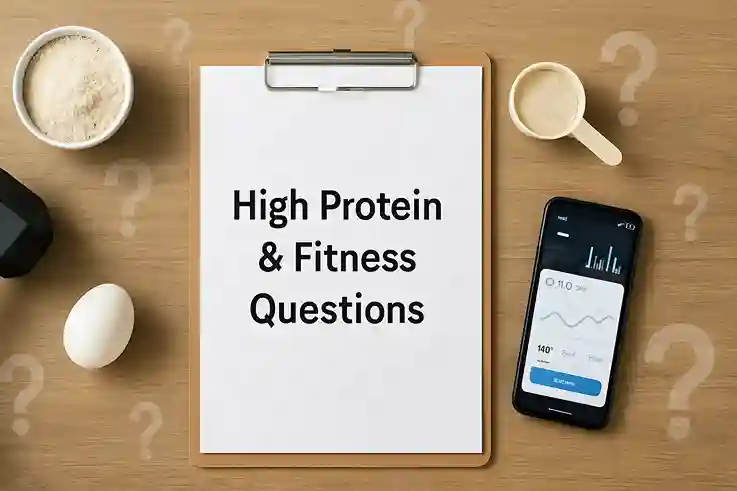
FAQs About High Protein Foods and Fitness
Conclusion
High protein foods are more than just a fitness trend—they’re foundational to transforming your body, strength, and energy. Whether you’re building muscle, recovering from injury, or aiming to lose fat, the right proteins help you do it better and faster. From complete animal-based proteins like salmon and eggs to powerful plant options like tofu and lentils, there’s a wide range of choices to suit every dietary preference.
But it’s not about eating more. It’s about eating smart. That means choosing quality sources, balancing macros, timing your intake, and tuning into how your body responds. Whether you’re a beginner or a seasoned athlete, high protein eating—done right—can change everything from your physique to your recovery time.
👉 What’s your go-to high protein food? Share your story or ask a question in the comments below.

Nick William is a dedicated travel blogger with a passion for uncovering hidden destinations and sharing authentic experiences from around the world. With a background in digital media and storytelling, he has developed a unique style that combines detailed research, vivid descriptions, and personal insights. His goal is to help readers not only plan their journeys but also connect with the culture, people, and stories behind each place.
When Nick isn’t exploring new cities or trekking off-the-beaten paths, he enjoys capturing moments through photography, reading history books, and sipping coffee while drafting his next adventure. His writing brings destinations to life, making every reader feel like a fellow traveler on the journey.
